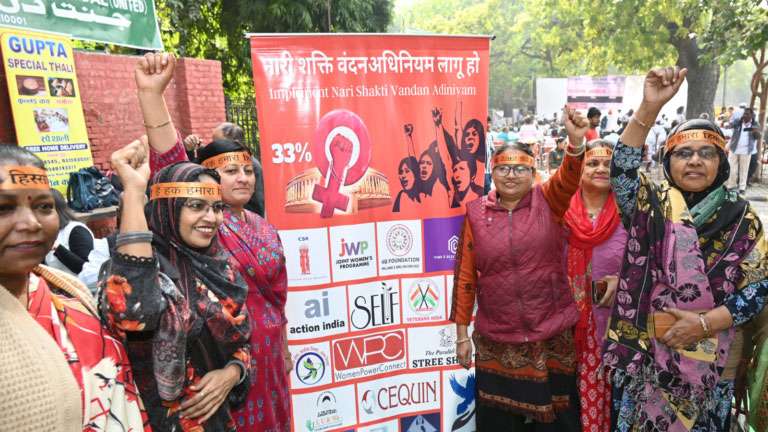

Written By: Dr. Ranjana Kumari, Director, Centre for Social Research and Chairperson, Women Power Connect
The passage of the Women’s Reservation Bill has been a monumental achievement for women’s rights in India. However, the subsequent discussions and delays surrounding its implementation have left many of us who tirelessly advocated for this bill feeling bewildered. The question arises: why must political parties wait for the finalization of seat delimitation and the conclusion of the census to allocate one-third of parliamentary seats to women for the 2024 elections?
It’s evident that when political parties allocate seats to their members, the primary criterion is often “sitting-getting.” Members who have not performed well may not receive nominations to contest. Additionally, a social engineering formula is frequently applied to ensure victory in a given seat. This involves matching the dominant caste combination with the caste or religion of the proposed candidate and assessing which other major caste or religious group will provide significant support to secure a win. Another crucial factor considered is the selected candidate’s ability to mobilize finances, manpower, and local election machinery for campaign funding and voter mobilization, especially on election day.
In the context of political party ticket distribution, it’s worth noting that the BJP distributed 56 tickets to women candidates in the 2019 elections, out of which 41 emerged victorious. This results in a remarkable 73% strike rate for BJP women candidates, surpassing the 66% strike rate of its 395 male candidates. This underscores how women’s participation has significantly influenced the overall nominations and subsequent election outcomes.
State-wise, Odisha leads the way with 16% of women candidates, followed by Chhattisgarh at 13%, and West Bengal and Uttarakhand both at 12%. These statistics encompass candidates from various parties within each state. When we compare these ratios to the percentage of women among MPs, we once again see how women tend to excel. The percentage of women MPs exceeds 15% in seven states, reflecting their capacity to secure victory and contribute to the political landscape.
What’s often overlooked in this complex process is the consolidation of the women’s vote, which has the potential to swing elections in favor of a particular candidate. In light of these considerations, it’s imperative that women be allocated 33% of seats based on their convictions and support, promoting women’s leadership within their respective parties.
Furthermore, we have witnessed effective women leaders emerging from the grassroots level, from Panchayati Raj to district leadership positions such as mayors and council members. These leaders have proven their mettle and are available to be selected from districts.
In terms of financial viability, women, standing on their own economic and financial strength, are more capable than ever of mobilizing resources. The dynamics of social engineering, where specific caste and religious combinations are favored, will work similarly for women candidates.
Additionally, it’s crucial to acknowledge women’s ability to secure victory in more seats compared to men in successive elections. Women are not perceived as frequent “Aayaram Gayaram” in today’s politics, individuals who switch parties frequently and negotiate positions of power. Recent political developments have shown how frequently elected mandates are undermined when governments change due to party-switching by elected representatives.
However, there’s a need for a deeper understanding of the importance of women’s political participation beyond just seat allocation. The Women’s Reservation Bill is not merely about providing a specific number of seats to women; it represents a transformative moment in Indian politics. It symbolizes a commitment to building a more inclusive and equitable society.
The passage of this bill acknowledges the capabilities of women, who constitute nearly half of India’s population. Women have consistently demonstrated their leadership and commitment to public service. However, their political representation remains disproportionate.
True democracy can only be achieved when women are given equal opportunities, and their voices are amplified. Allocating one-third of parliamentary seats to women is not just about numbers; it’s about recognizing the potential of women leaders to bring about positive change in our society.
Moreover, it’s essential to understand that women’s leadership extends beyond tokenism. Women leaders have played pivotal roles in addressing critical issues, from women’s rights and safety to healthcare and education. They bring unique perspectives and priorities to the table, enriching the policymaking process.
Today, women’s participation in politics goes beyond merely contesting elections. Women leaders have been at the forefront of grassroots movements, advocating for change and working towards gender equality. They have shown exceptional dedication and leadership in various fields.
In terms of economic empowerment, women entrepreneurs have made significant strides, contributing to India’s economic growth. Their businesses have thrived, creating jobs and driving innovation. Empowering women in politics is a natural extension of this progress.
In conclusion, the passage of the Women’s Reservation Bill was a historic achievement, but its true impact lies in its implementation. Allocating one-third of parliamentary seats to women should not be contingent on external factors like delimitation and census results. Instead, it should be a commitment to gender equality and women’s empowerment.
Let us seize this opportunity to promote women’s leadership in Indian politics, not as a matter of favor or tokenism, but as a recognition of their capabilities and contributions. The time has come for political parties to honor their commitment and fulfill their promises to women. It’s time for them to walk the talk and work towards a more inclusive and equitable society for all.





